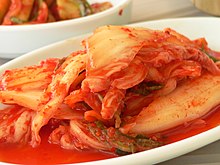Chinese cabbage
| Chinese cabbage | ||||||||||||
|---|---|---|---|---|---|---|---|---|---|---|---|---|

Chinese cabbage ( Brassica rapa subsp. Pekinensis ) |
||||||||||||
| Systematics | ||||||||||||
|
||||||||||||
| Scientific name | ||||||||||||
| Brassica rapa subsp. pekinensis | ||||||||||||
| ( Lour. ) Hanelt |
Chinese cabbage ( Brassica rapa subsp. Pekinensis , Syn . : Brassica rapa subsp. Glabra , B. pekinensis (Loureiro) Ruprecht ), also known as Peking cabbage , Japanese cabbage , celery cabbage , is a vegetable. Chinese cabbage forms a firm, oval to narrow cylindrical head with a weight of approx. 1–3 kg. Its leaves are mostly yellow-green and have broad, white, slightly curled leaf veins. There are many cultivars of Chinese cabbage . It is available all year round, with its main harvest season being October and November. Chinese cabbage can be used in many ways as a food in the kitchen. Not to be confused with this is the Chinese mustard cabbage (see Pak Choi ), which has slightly smaller heads and dark green leaves similar to the Swiss chard .
Origin and history
Chinese cabbage is said to have originated from a cross between the turnip and mustard cabbage . It was first cultivated in China in the 5th century and is called Baicai ( Chinese 白菜 , Pinyin báicài - "white vegetables") or Dabaicai ( 大白菜 , dàbáicài - "large white vegetables"). From the 15th century it was also used in Korea as baechu - RR or paech'u - MR ( kor. 배추 ) and from the 19th century in Japan as hakusai ( Japanese 白菜 , kana は く さ い ) or paku choi ( kana パ ク チ ョ イ ) cultivated. Chinese cabbage has been known in Europe since the beginning of the 20th century.
use
Chinese cabbage is used as a vegetable in soups, wok dishes and salads. Fermented with lactic acid as kimchi in Korea and as “hakusaizuke” ( Japanese 白菜 漬 け or は く さ い づ け , “pickled Chinese cabbage / pickled hakusai / literally pickled white vegetables”) in Japan it is a typical dish. The taste of the variety cultivated in Japan, Japanese cabbage - 日本 大白菜 , Rìběn dàbáicài , stands out a little more finely than the other varieties.
ingredients
Chinese cabbage contains the following noteworthy substances, especially potassium , calcium and folic acid . The values serve as a general orientation and are not fixed, as the environmental conditions of the growing area also have an influence on these values.
| Calorific value | water | fat | protein | carbohydrates | Fiber | sugar |
|---|---|---|---|---|---|---|
| 67 kJ (16 kcal) | 95 g | 0.2 g | 1.2 g | 3.2 g | 1.2 g | 1.4 g |
| Sat. Fatty acids | Simple unsaturated Fatty acids | Multiple unsaturated Fatty acids | Folic acid |
|---|---|---|---|
| 43 mg | 23 mg | 72 mg | 79 µg |
| iron | copper | potassium | Calcium | Magn. | sodium | phosphorus | selenium | zinc |
|---|---|---|---|---|---|---|---|---|
| 0.31 mg | 36 µg | 240 mg | 77 mg | 13 mg | 9 mg | 29 mg | 0.6 µg | 0.23 mg |
| β-carotene | Vita. A. | Vita. B1 | Vita. B2 | Vita. B3 | Vita. B5 | Vita. B6 | Vita. C. | Vita. K1 |
|---|---|---|---|---|---|---|---|---|
| 0.19 mg | 16 µg | 40 µg | 50 µg | 0.4 mg | 0.11 mg | 0.23 mg | 27 mg | 43 µg |
Source for tables:
- annotation
Pests
The pupae of the cabbage fly can often be found in the leaves of the Chinese cabbage .
Trivia
In Chinese art , the Chinese cabbage can be seen as a motif in the form of the famous jade cabbage in the collections of the Palace Museum of Beijing , Tianjin and Taipei as a national treasure.
Please refer
Web links
- Chinese cabbage in the crop database of the University of Marburg
Individual evidence
- ↑ a b c Chinese cabbage - scientific name "Brassica rapa pekinensis" / "Brassica rapa glabra" / "B. pekinensis (Loureiro) Ruprecht". In: www.efloras.org. Retrieved January 26, 2016 .
- ↑ a b Chinese cabbage - scientific name "Brassica rapa pekinensis" / "Brassica rapa glabra" / "B. pekinensis (Loureiro) Ruprecht" ( Memento from October 25, 2016 in the Internet Archive ). In: fooddb.com.hk, accessed January 20, 2020 (Chinese, English)
- ↑ a b Chinese cabbage - scientific name "Brassica rapa pekinensis" / "Brassica rapa glabra" / "B. pekinensis (Loureiro) Ruprecht". In: www.lebensmittellexikon.de. Retrieved January 26, 2016 .
- ↑ term "배추 - cabbage version baechu - Chinese cabbage". In: dict.naver.com. Retrieved February 4, 2020 (German, Korean).
- ↑ term "白菜- hakusai - Chinese cabbage". In: Wadoku . Retrieved February 4, 2020 (German, Japanese).
- ↑ Term "パ ク チ ョ イ - paku choi - Chinese cabbage". In: Wadoku . Retrieved February 4, 2020 (German, Japanese).
- ↑ Chinese Cabbage (Pe-tsai) - nutritional values, calories and ingredients. In: vegane-fitnessernaehrung.de. Retrieved January 20, 2020 .
- ↑ Chinese Cabbage (Pe-tsai), Cooked - Nutritional Values, Calories, and Ingredients. In: vegane-fitnessernaehrung.de. Retrieved January 20, 2020 .
- ↑ Souci / specialist / herb. German Research Institute for Food Chemistry, 5th edition, 1994.

